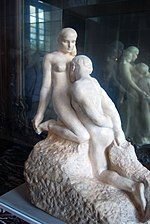Marble sculpture
 |
|
|
|
Marble sculpture is the art of creating three-dimensional forms from marble. Sculpture is among the oldest of the arts. Even before painting cave walls, early humans fashioned shapes from stone. From these beginnings, artifacts have evolved to their current complexity.
Marble is a metamorphic rock derived from limestone, composed mostly of calcite (a crystalline form of calcium carbonate, CaCO3). The original source of the parent limestone is the seabed deposition of calcium carbonate in the form of microscopic animal skeletons or similar materials. Marble is formed when the limestone is transformed by heat and pressure after being overlain by other materials. The finest marbles for sculpture have no or few stains (some natural stain can be seen in the sculpture shown at left, which the sculptor has skillfully incorporated into the sculpture).
Among the commonly available stones, only marble has a slight translucency i.e. subsurface scattering that is comparable to that of human skin. It is this translucency that gives a marble sculpture a visual depth beyond its surface and this evokes a certain realism when used for figurative works. Marble also has the advantage that, when first quarried, it is relatively soft and easy to work, refine, and polish. As the finished marble ages, it becomes harder and more durable. Preference to the cheaper and less translucent limestone is based largely on the fineness of marble's grain, which enables the sculptor to render minute detail in a manner not always possible with limestone; it is also more weather-resistant.
Marble does not bear handling well as it will absorb skin oils when touched, which leads to yellow brownish staining. While more resistant than limestone it is subject to attack by weak acids, and so performs poorly in outdoor environments subject to acid rain. For severe environments, granite is a more lasting material but one which is far more difficult to work and much less suitable for refined works. Compared to metals such as bronze, marble lacks ductility and strength, requiring special structural considerations when planning a sculpture. In the sculpture shown to the right, the figure can be placed upon slender lower legs and the balls of the feet only because the bending stress in the sculpture is taken through the flowing drapery of the skirt, which is founded upon an upthrust portion of the ground and with the feet forms a tripod-like foundation for the mass. For comparison see some of the examples in the article concerning bronze sculpture (especially the sculpture Jeté) for the ease with which action and extension may be expressed.
...
Wikipedia
